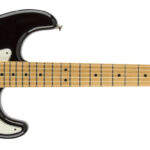The Martin HD-28 guitar stands as a cornerstone in the world of acoustic instruments, revered for its rich history and iconic sound. To truly appreciate the HD-28, it’s essential to understand its lineage, tracing back to the very origins of the dreadnought design and the evolution of the D-28.
When Martin first conceived the dreadnought body shape, it was characterized by scalloped braces, a feature shared with their other guitar models at the time. The earliest D-28s, adopting the dreadnought form, were 12-fret guitars, though these were produced in very limited numbers in the early 1930s. A significant shift occurred in 1934 when Martin transitioned the dreadnought to a 14-fret design. This pivotal change proved to be a turning point, with 14-fret dreadnought production in 1934 surpassing the total 12-fret dreadnought output of the preceding three years. Style 28 guitars, known for their rosewood back and sides, also featured herringbone purfling during this era. Consequently, a D-28 of that period embodied herringbone trim and scalloped braces as standard appointments. The bracing was also positioned in what is now termed the “forward-shifted” position, relative to the soundhole.
Throughout the 1930s and 1940s, the D-28 underwent a series of modifications. The scalloped braces evolved to tapered and then to straight (non-scalloped), the brace positioning shifted from “forward” to “rear” and finally to the “standard” position, and the herringbone purfling was replaced by a black and white multi-stripe design. By approximately 1946, the D-28 had transformed from its initial specifications of scalloped, forward-shifted braces and herringbone trim to straight, standard-shifted braces and multi-stripe purfling. An additional change in 1939 saw the nut width narrow from 1-3/4 inches to 1-11/16 inches.
For several decades, the D-28 remained largely unchanged. While Martin adjusted tonewoods over the years—moving from red spruce to Sitka spruce in the 1940s and transitioning from Brazilian rosewood to East Indian rosewood in the late 1960s—these alterations are less pertinent to understanding the later emergence of the HD-28. As players began to rediscover and value the sonic qualities of the original D-28s, demand grew for Martin to reintroduce scalloped bracing. However, Martin initially resisted this shift. The closest concession during the 1960s was the use of 1/4″ straight braces on the D-35. Independent luthiers began crafting guitars in the older style, incorporating scalloped braces, but Eric Schoenberg’s influence was particularly significant. In the early 1970s, Schoenberg conceived the idea to revive the OM guitars (which included scalloped bracing), a model Martin had discontinued in the 1930s. Schoenberg’s collaborators in this venture would become luminaries in guitar making. He initiated the project with Dana Bourgeois, who crafted and voiced the tops. In the early stages, these tops were sent to Martin to be joined with backs and sides and assembled.
Responding to market demand and recognizing the success of the Schoenberg OM guitars, Martin reintroduced scalloped bracing in 1976. Instead of simply reverting the D-28 to scalloped bracing, Martin introduced a new model: the HD-28. Paying further homage to the D-28’s heritage, the HD-28 incorporated herringbone purfling, hence the “H” designation in its name. The standard D-28 remained in production, retaining straight braces and multi-stripe purfling.
Although the HD-28 models featured scalloped bracing and herringbone trim reminiscent of the original D-28s, they still incorporated standard-shifted braces and a 1-11/16″ nut width, which were standard features of the time. A 1993 HD-28, for example, would largely reflect these specifications. Starting in 2012, Martin began refining the design of the D-18 to more closely resemble the original D-18 models, changes that were widely well-received. Martin extended these design philosophies across its Standard Series, including Style 28 guitars, in 2018 as part of the “reimagined” series. The D-28 itself was “reimagined” in 2017, preceding the broader series update.
Key distinctions between a pre-reimagined and reimagined HD-28 include: the shift from standard to forward-shifted bracing, a change from a 1-11/16″ nut to a wider 1-3/4″ nut, a transition from a Low Profile neck with a standard taper to a Modified Low Oval neck profile with a “performing artist” taper, alterations in string spacing at the bridge from 2-1/8″ to 2-5/64″, the adoption of old-style diamond and squares fretboard inlays replacing simple dots, the move from closed to open-gear tuners, and a switch from a gold foil to a decal logo on the headstock.
For a more detailed exploration of this topic, this link offers an extended history of the Martin D-28 and HD-28.

